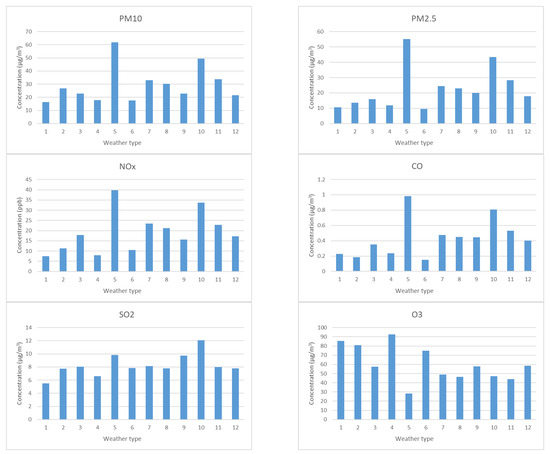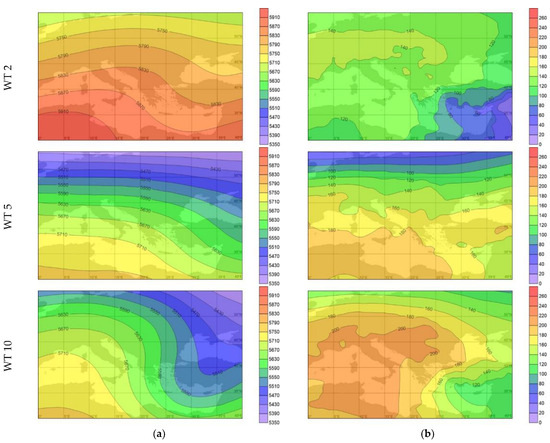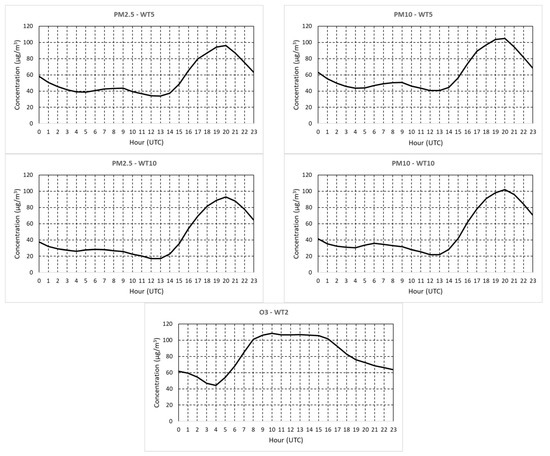Abstract
The dependence of the atmospheric pollution levels on the synoptic conditions and the associated prevailing weather regimes over Ioannina was examined for the 3-year period of 15 February 2019–14 February 2022. The study period is constrained by the availability of quality local air (particulate and gaseous) pollution measurements. The data used consist of (1) daily grid point values of the main meteorological parameters over the geographical domains of southeastern Europe and the greater Epirus region, obtained from ERA5 Reanalysis database and (2) hourly values of the main meteorological parameters and the concentration of basic pollutants recorded at the automatic environmental station of the Epirus Region located at the center of Ioannina. At first, 12 Weather Types (WTs) were defined on daily basis by applying a multivariate statistical methodology including Factor Analysis and k-means Cluster Analysis of the meteorological data. Next, for each WT, the average values, the standard deviations and the mean diurnal variations in the pollutant concentrations were calculated. According to the results, it appears that almost all pollutant concentrations were considerably higher during two anticyclonic WTs prevailing in the cold period of the year, while the diurnal variations in the concentrations were affected by the diurnal variations in traffic, combustion processes and solar radiation. The exact influence of the above factors depends on the characteristics of the prevailing WT.
1. Introduction
Air pollution is a common problem in big crowded cities around the world. It is well known that air pollution levels are generally affected by meteorological conditions. In Greece, many studies have been conducted concerning the connection between air quality in the two biggest cities, i.e., Athens and Thessaloniki, and the local and/or large-scale meteorological conditions [1,2,3,4,5]. Furthermore, the classification of Weather Types (WTs) is a research subject which has been extensively studied by many researchers in the past [6,7,8]. A weather type (WT) corresponds to a specific meteorological condition prevailing over a geographical area, associated with a specific characteristic mode of large-scale atmospheric circulation. The characteristics of a WT can be quantified with the use of the corresponding values of the main meteorological parameters over the area of interest and the large-scale atmospheric circulation parameters prevailing over a greater geographical area. There are many methods that have been used in the past for the definition of WTs.
In the present study, the dependence of the atmospheric pollution levels on the prevailing WTs is examined for the city of Ioannina (NW Greece). A multivariate statistical methodology, which includes a dimensionality reduction technique followed by a classification technique, has been used for the definition of WTs based on meteorological data for the Ioannina area, the Epirus region and southeastern Europe. The pollution levels were examined for each of the defined WTs. This examination included the mean pollutant concentrations as well as their diurnal variations.
2. Data and Methodology
The data used consist of (1) daily (12UTC) 1° × 1° grid point values of 500 hPa and 1000 hPa geopotential heights and 850 hPa air temperature over southeastern Europe (30° N–55° N, 0°–40° E) and 6-hourly 0.25° × 0.25° grid point values (00, 06, 12 and 18 UTC) of air temperature and dew points at 2 m, zonal and meridional wind components at 10 m and total cloud cover over the greater Epirus region (38.5° N–40.5° N, 19.5° E–21.5° E), obtained from the ERA5 Reanalysis database [9,10] and (2) hourly values of air temperature, relative humidity, zonal and meridional wind components and the concentration of basic pollutants (PM10, PM4, PM2.5, PM1, NO, NO2, NOx, CO, SO2 and O3) recorded at the automatic environmental station of the Epirus Region located at the center of Ioannina, for the 3-year period of 15 February 2019–14 February 2022.
Weather Types (WTs) were defined on daily basis by applying a multivariate statistical methodology including Factor Analysis and k-means Cluster Analysis of the meteorological data. Factor Analysis is a statistical method used for the reduction of the dimensionality of a data set. This is achieved with the definition of a small number of new variables expressing a large percentage of the variance of the initial data set [11]. k-means Cluster Analysis is a statistical method which classifies cases in a data set into distinct and homogenous groups (clusters) using the squared Euclidian distance between them [12]. In the present work, Factor Analysis contributed to the reduction of the dimensionality of the initial meteorological data sets and k-means Cluster Analysis classified the days into groups defining the WTs. For the selection of the appropriate number of clusters, the distortion test was used [13]. For each WT, the mean daily values and the mean diurnal variations of the pollutant concentrations were calculated.
3. Results and Discussion
Factor Analysis was applied on three data matrices. Specifically, it was applied separately the following matrices: (1) 500 hPa and 1000 hPa geopotential heights and 850 hPa air temperature over SE Europe resulting in six factors (87% of the total variance); (2) 2 m air temperature and dew point, 10 m zonal and meridional wind components and total cloud cover over the greater Epirus region resulting in five factors (69% of the total variance); and (3) air temperature, relative humidity and wind components (zonal and meridional) in Ioannina resulting in seven factors (78% of the total variance). Next, k-means Cluster Analysis was applied on the unified matrix of all factor scores resulting in 12 clusters that define the 12 WTs.
From the 12 WTs, 5 WTs corresponded to the cold period of the year, 2 WTs corresponded to the warm period of the year and 5 WTs referred to the transitional seasons. For each WT, the mean concentrations of all pollutants were calculated. In Figure 1, the mean concentrations of PM10, PM2.5, NOx, CO, SO2 and O3 are presented for all WTs. The corresponding values of the rest of the pollutants (PM1, PM4, NO and NO2) are not presented due to the space limitations of the article. As can be seen in Figure 1, the most interesting WTs in terms of air pollution levels are WTs 4, 5 and 10. Specifically, for PM2.5, PM10, NOx, CO and SO2, the highest concentrations were recorded when WTs 5 and 10 prevailed, while the maximum concentration of O3 appeared for WT4. For WT5, mean PM10 and PM2.5 concentrations exceeded 60 and 50 mg/m3, respectively, while mean NOx concentration approached 40 ppb. For WT10, PM10 and PM2.5 concentrations were slightly lower relative to WT5 (about 50 and 43 mg/m3, respectively), while the NOx concentration reached 34 ppb. For WT4, the mean O3 concentration exceeded 90 mg/m3, which was the highest level among the 12 WTs. It is noted that, according to the intra-annual variation of the WTs’ frequency (figure not shown), WTs 5 and 10 are cold season WTs, while WT4 is a transitional season WT. Since WT4 includes a very small number of days, WT2 was examined instead of WT4, as it prevailed for a considerable number of days and presented high ozone concentration too. In order to examine the synoptic conditions favoring the above pollution level characteristics for WTs 2, 5 and 10, the corresponding mean 12UTC 500 hPa and 1000 hPa geopotential patterns are presented (Figure 2). It was seen that both cold season WTs 5 and 10 were characterized by a ridge over the Balkans, associated with anticyclonic conditions near the surface. Such anticyclonic conditions favor subsidence, clear skies, surface inversion and relatively low temperatures, especially in the night and early morning. Such conditions favor the accumulation of atmospheric pollutants in the lowest tropospheric levels because of the absence of horizontal and vertical mixing and the emission of pollutants related to biomass burning for house heating. This can justify the highest concentrations of almost all pollutants (except O3) during these two WTs. In terms of O3, it is noted that it is a photochemical pollutant and therefore it is expected that its maximum concentration would appear during a warm season WT. WT2 is one of the two warm season WTs defined and it is characterized by typical summer synoptic conditions over the Balkans associated with anticyclonic activity, clear skies and sunshine. The intense solar radiation and the calm conditions over NW Greece favor the accumulation of O3.

Figure 1.
Mean concentrations of PM10, PM2.5, NOx, CO, SO2 and O3 for each of the defined WTs.

Figure 2.
Mean 12UTC patterns of (a) 500 hPa and (b) 1000 hPa geopotential height (gpm) for WTs 2, 5 and 10.
The mean diurnal variations of PM2.5 and PM10 concentrations for WTs 5 and 10 and O3 concentration for WT2 are presented in Figure 3. It is shown that, in terms of PM2.5 and PM10, the maximum concentration appeared in the evening and exceeded 90 and 100 mg/m3, respectively, for both WTs. This is connected to the increased biomass burning for house heating purposes in the evening. In terms of the diurnal variation in O3 concentration, the maximum was found during the day and specifically during periods of intense solar radiation, as expected for a photochemical pollutant like ozone.

Figure 3.
Mean diurnal variations of PM2.5 and PM10 concentrations for WTs 5 and 10 and O3 concentration for WT2.
4. Conclusions
The synoptic conditions favoring high atmospheric pollution levels were examined for the city of Ioannina in NW Greece and the main conclusions are the following:
- Anticyclonic activity associated with clear skies and calm conditions favor the domination of surface inversions which are responsible for high concentrations of most of the atmospheric pollutants during the cold period of the year.
- The house heating associated with biomass burning during winter temperature inversions leads to an evening maximum in the diurnal variation of PM10, PM4, PM2.5, PM1, NO, NO2, NOx, CO and SO2 concentrations.
- O3 is the only pollutant which was found to increase during the warm period of the year because of its photochemical origin.
Author Contributions
Conceptualization, C.J.L. and N.H.; methodology, C.J.L.; software, A.S.; validation, A.S.; data curation, A.S.; writing—original draft preparation, A.S.; writing—review and editing, A.S., C.J.L. and N.H.; visualization, A.S. and C.J.L.; supervision, C.J.L. and N.H. All authors have read and agreed to the published version of the manuscript.
Funding
This research received no external funding.
Institutional Review Board Statement
Not applicable.
Informed Consent Statement
Not applicable.
Data Availability Statement
Data are available on request.
Acknowledgments
We wish to acknowledge the use of ECMWF computing and archive facilities in this research, which were generated using Copernicus Climate Change Service information.
Conflicts of Interest
The authors declare no conflict of interest.
References
- Katsoulis, B.D. The Relationship between Synoptic, Mesoscale and Microscale Meteorological Parameters during Poor Air Quality Events in Athens, Greece. Sci. Total Environ. 1996, 181, 13–24. [Google Scholar] [CrossRef]
- Katragkou, E.; Kazadzis, S.; Amiridis, V.; Papaioannou, V.; Karathanasis, S.; Melas, D. PM10 Regional Transport Pathways in Thessaloniki, Greece. Atmos. Environ. 2009, 43, 1079–1085. [Google Scholar] [CrossRef]
- Hatzianastassiou, N.; Katsoulis, B.D.; Antakis, B. Extreme Nitrogen Oxide and Ozone Concentrations in Athens Atmosphere in Relation to Meteorological Conditions. Environ. Monit. Assess. 2007, 128, 447–464. [Google Scholar] [CrossRef] [PubMed]
- Sindosi, O.A.; Katsoulis, B.D.; Bartzokas, A. An Objective Definition of Air Mass Types Affecting Athens, Greece; the Corresponding Atmospheric Pressure Patterns and Air Pollution Levels. Environ. Technol. 2003, 24, 947–962. [Google Scholar] [CrossRef] [PubMed]
- Kassomenos, P.A.; Sindosi, O.A.; Lolis, C.J.; Chaloulakou, A. On the Relation Between Seasonal Synoptic Circulation Types and Spatial Air Quality Characteristics in Athens, Greece. J. Air Waste Manag. Assoc. 2003, 53, 309–324. [Google Scholar] [CrossRef] [PubMed]
- Macheras, P. Weather-type classification by factor analysis in the Thessaloniki area. J. Climatol. 1984, 4, 437–443. [Google Scholar] [CrossRef]
- Littmann, T. An empirical classification of weather types in the Mediterranean Basin and their interrelation with rainfall. Theor. Appl. Climatol. 2000, 66, 161–171. [Google Scholar] [CrossRef]
- Lolis, C.J.; Kotsias, G.; Bartzokas, A. Objective Definition of Climatologically Homogeneous Areas in the Southern Balkans Based on the ERA5 Data Set. Climate 2018, 6, 96. [Google Scholar] [CrossRef]
- Hersbach, H.; Bell, B.; Berrisford, P.; Biavati, G.; Horányi, A.; Muñoz Sabater, J.; Nicolas, J.; Peubey, C.; Radu, R.; Rozum, I.; et al. ERA5 Hourly Data on Pressure Levels from 1940 to Present. Copernicus Climate Change Service (C3S) Climate Data Store (CDS). 2023. Available online: https://cds.climate.copernicus.eu/cdsapp#!/dataset/10.24381/cds.bd0915c6?tab=overview (accessed on 28 September 2022).
- Hersbach, H.; Bell, B.; Berrisford, P.; Biavati, G.; Horányi, A.; Muñoz Sabater, J.; Nicolas, J.; Peubey, C.; Radu, R.; Rozum, I.; et al. ERA5 Hourly Data on Single Levels from 1940 to Present. Copernicus Climate Change Service (C3S) Climate Data Store (CDS). 2023. Available online: https://cds.climate.copernicus.eu/cdsapp#!/dataset/reanalysis-era5-single-levels?tab=overview (accessed on 28 September 2022).
- Jolliffe, I.T. Principal Component Analysis; Springer: New York, NY, USA, 1986. [Google Scholar]
- Sharma, S. Applied Multivariate Techniques; John Wiley & Sons: New York, NY, USA, 1995; p. 512. ISBN 978-0471310648. [Google Scholar]
- Sugar, C.A.; James, G.M. Finding the Number of Clusters in a Dataset. J. Am. Stat. Assoc. 2003, 98, 750–763. [Google Scholar] [CrossRef]
Disclaimer/Publisher’s Note: The statements, opinions and data contained in all publications are solely those of the individual author(s) and contributor(s) and not of MDPI and/or the editor(s). MDPI and/or the editor(s) disclaim responsibility for any injury to people or property resulting from any ideas, methods, instructions or products referred to in the content. |
© 2023 by the authors. Licensee MDPI, Basel, Switzerland. This article is an open access article distributed under the terms and conditions of the Creative Commons Attribution (CC BY) license (https://creativecommons.org/licenses/by/4.0/).